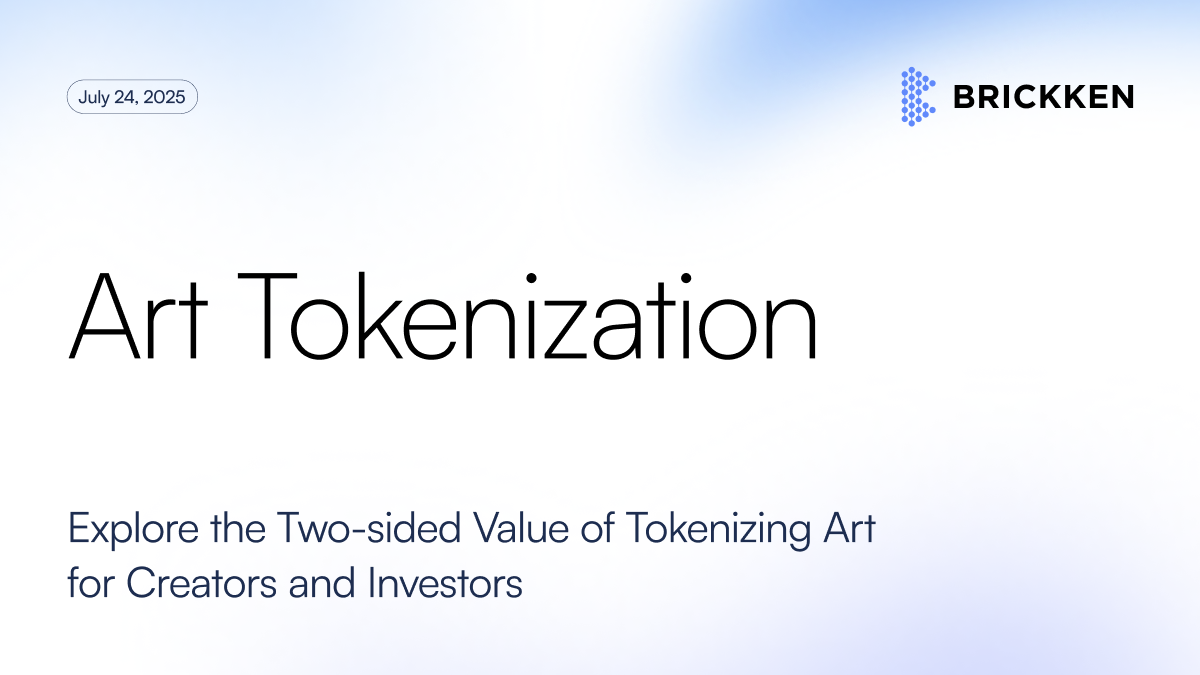TL;DR
Tokenization is changing how the art world creates, owns, and invests. This blog explains the two-sided value of art tokenization:
- For artists and collectors: More ways to earn money, reach global markets, and protect their work.
- For investors: Access to small shares in high-value art, plus chances to earn income.
- How it works: Smart contracts on the blockchain enable the creation and management of digital tokens that represent ownership rights or revenue claims. They are tied to physical or digital artworks.
- Real-world impact: From Banksy and Warhol to Brickken’s Kowalski project, tokenization is opening up the art economy.
The Two-Sided Value of Tokenizing Art
Art tokenization refers to the process of creating digital tokens that represent financial rights or ownership claims to a piece of art. These tokens can represent part ownership, profit rights, or voting power. This process enables fractional ownership and automates key functions using smart contracts.
Here’s what both sides gain:
- Artists and collectors can raise funds in new ways, improve cash flow, and retain full control over intellectual property.
- Investors can enter the art market with less capital and diversify their portfolios.
With the global art market valued at over $65 billion, tokenization is making art investment more accessible and fair.
For Artists and Collectors: Monetization, IP Protection, and Reach
Tokenization provides useful tools for creators and owners:
New revenue models
- Artists can raise funds for upcoming collections before they're even completed.
- Collectors can sell portions of their art while maintaining full physical possession.
- Ongoing earnings are possible through revenue participation.
Built-in royalties and IP protection
- Smart contracts ensure that artists automatically receive royalties from resales.
- Blockchain technology secures ownership records and helps prevent fraud.
Global reach
Artists no longer need to rely on traditional galleries. With tokenization, they can connect directly with:
- Crypto investors worldwide
- Institutions exploring tokenization of real-world assets
- Fans who want to financially support the art they admire
For Investors: Access, Income, and Transparency
Art is a promising alternative investment. Tokenization makes it easier for more people to participate:
Lower barriers to entry
- Fractional tokens let investors buy into high-value art using smaller amounts of money.
- Tokens are flexible and can be held or sold.
New income opportunities
- Some art tokens generate returns from licensing or future resales.
- Platforms may also link tokenized art to DeFi tools for extra earning potential.
Greater transparency and liquidity
- All transactions and ownership records are visible on the blockchain.
- Secondary marketplaces allow easier buying and selling.
How Art Tokenization Works
Here’s what the process usually looks like:
- The artwork’s ownership and legal rights are verified and documented.
- Tokens are created to digitally represent ownership rights or revenue claims related to the artwork.
- A smart contract sets the rules for ownership, royalties, and decision-making.
- Tokens are distributed through a secure, regulated platform.
The platform tracks everything from payments to changes in ownership.
Platforms like Brickken simplify this by offering:
- No-code tools for token creation
- Compliance with KYC and AML standards
- Automated smart contract functions
Dashboards for ongoing asset and investor management
Real-World Examples: Kowalski and the New Art Economy
- Banksy’s “Love is in the Air”: Sold as tokenized shares. More than 10,000 people invested and raised $5 million in two hours.
- Andy Warhol’s “14 Small Electric Chairs”: Sold to a global investor base, which helped make the asset more accessible and tradable.
Brickken Use Case: Kowalski Art Tokenization
Brickken worked with Helm Capital Group has successfully closed a $250,000 funding round for the Off-Broadway production "Kowalski". This initiative:
- Opened up valuable art to fractional investors
- Maintained full legal compliance throughout
- Delivered automatic royalties through smart contracts
- Attracted investors with a focus on cultural and creative assets
This use case highlights how tokenization can expand reach and maintain integrity at the same time.
A Future Where Everyone Can Own a Piece of Art
Art tokenization is part of a larger shift. As more real-world assets become tokenized, art is helping lead the way:
- Communities are forming Cultural DAOs, which are blockchain-based collectives, to co-own artwork
- Artists and producers are using tokens to fund films and music
- New Web3-native galleries are launching equity tokens linked to digital portfolios
This is not just a tech trend. It’s a change in how we think about access and value in the art world.
Final Thought: Creative Equity for a New Era
Tokenization isn’t only about liquidity. It creates creative equity. Artists and collectors gain tools to grow, and investors access a new, meaningful asset class.
Brickken supports this evolution with a flexible, secure platform built for compliant, global engagement.
Interested in asset tokenization or digital assets investment? Talk with our specialists
